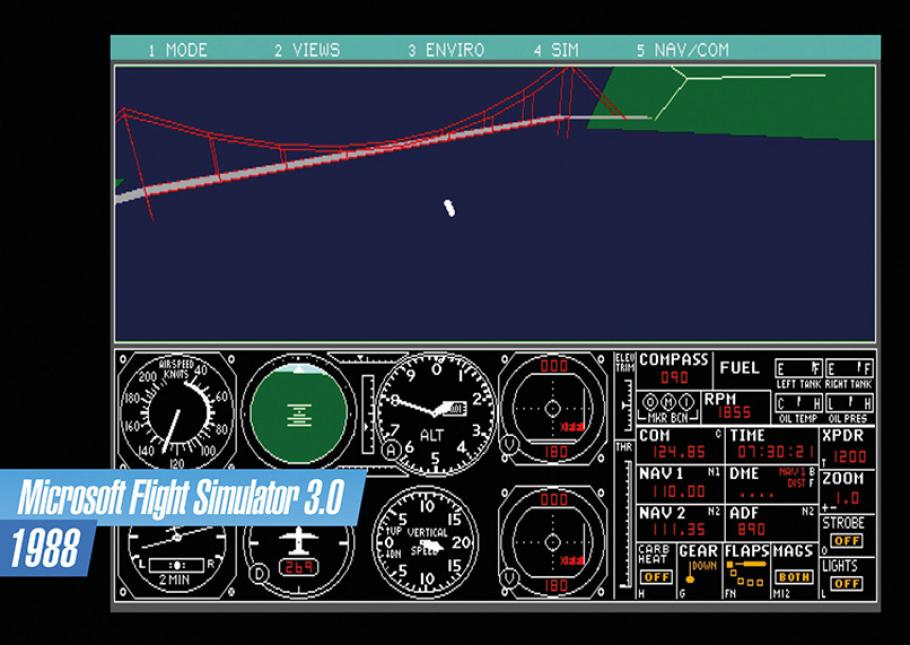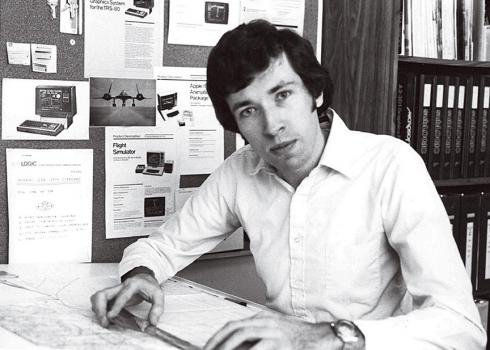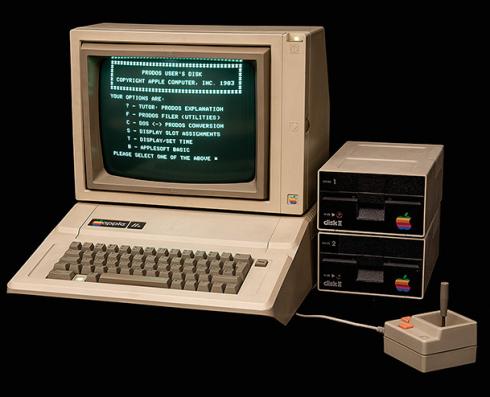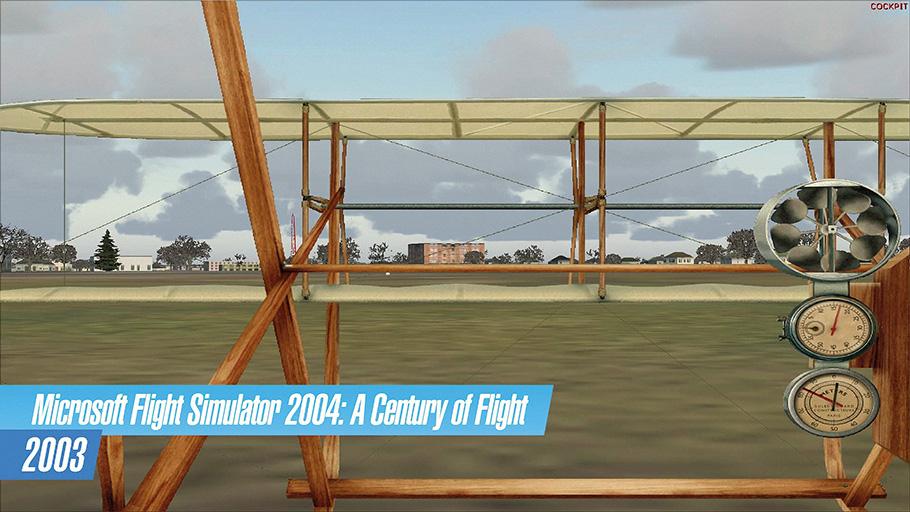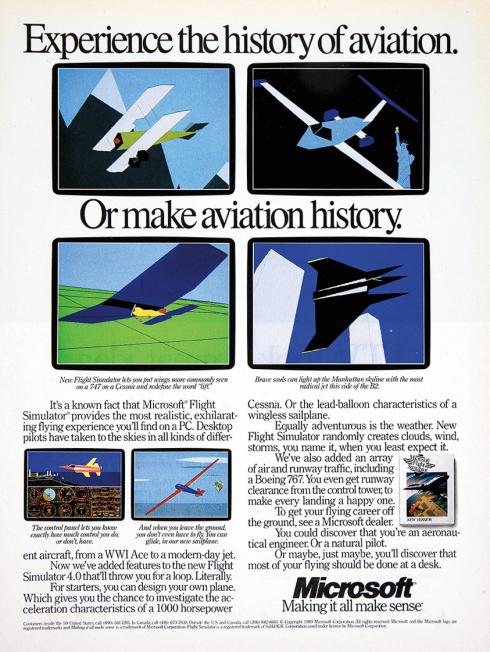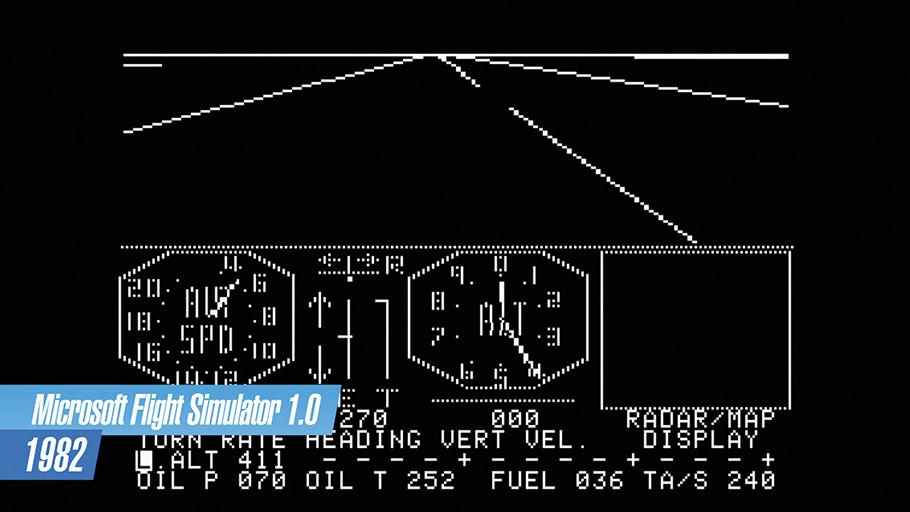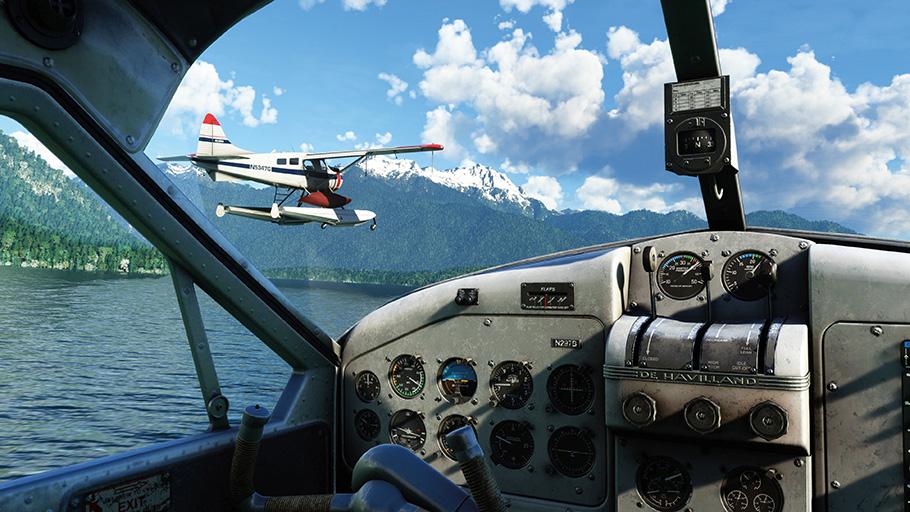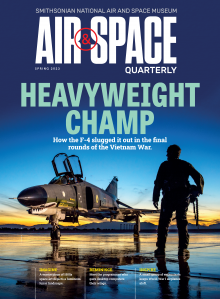Forty years ago, a software engineer with a passion for aviation taught desktop computers how to fly.
Bruce Artwick can’t remember exactly where or when he had the epiphany that launched the home flight-simulator industry. But he vividly recalls what happened during an otherwise forgettable lunchtime presentation and how it galvanized him to take action.
It was the summer of 1978, and the digital revolution was gathering momentum. The previous year had seen the debut of the so-called trinity of turn-key microcomputers—the Apple II, Radio Shack TRS-80, and Commodore PET 2001. But these were still early days. Computer stores were as rare as unicorns, and if a bookstore had a computer section, it consisted of a single shelf sparsely populated with esoteric how-to manuals.
Despite the arrival of the trinity, off-the-shelf computers were the exception. Most computers were homebuilt rigs assembled from components sold by various startups—a chassis here, a motherboard there. A handful of startups offered third-party software, but it tended to be buggy and not very useful. “The field was so new,” says Artwick. “And there was so much opportunity.”
Then 25 years old, Artwick was uniquely positioned to profit from the coming wave. He’d studied both electrical engineering and computer science at the University of Illinois Urbana-Champaign, and he was both a hardware virtuoso and a software savant. For his master’s thesis, Artwick wrote a pioneering program that could be used to generate three-dimensional graphics for a hypothetical flight simulator. He parlayed this expertise into an engineering gig at Hughes Aircraft. Shortly after moving to southern California, he and a friend from college, Stu Moment, formed a company to sell retail versions of his 3D graphics software. While Artwick worked full-time at Hughes, Moment and his wife copied programs on cassettes in their trailer home in Champaign.
This 1988 version of Microsoft Flight Simulator rendered in simple lines and geometric shapes.
Although Moment was the one with the marketing degree, Artwick was in charge of creating buzz for their product. It wasn’t easy. The company didn’t have an advertising budget, but, in those days, what mattered most was word of mouth. So Artwick showed the flag up and down the state of California. He rented booths at computer fairs. He set up folding tables at swap meets. He even gave demonstrations to the early adopters and DIYers who’d formed small but rabid computer clubs. Most of these presentations featured the same spiel.
But on one summer afternoon, for reasons even Artwick can’t articulate, he added a new wrinkle: “You could take one of these 3D graphics packages, combine it with some flight equations, and you’d have a desktop flight simulator,” he told the group.
The moment the words left his mouth, there was an audible gasp, and a sense of excitement buzzed through the room like an electric current. “And I thought to myself, ‘I could have something here,’ ” Artwick recalls with a laugh.
Artwick quit Hughes, moved back to Champaign, and single-handedly wrote the code for the program that debuted in early 1980 as Flight Simulator, first for the Apple II and then ported to the TRS-80. “Sales were just fantastic—more than we could believe,” says Moment. Artwick remembers being stunned when Moment told him that a distributor wanted 1,000 copies. “We were used to selling 10s and 20s, quantities like that,” he says. “So I made this bank of 16 cassette recorders that all worked in parallel to record the cassettes, and then we rented a facility that Stu was using to make boxes. Actually, for a while there, we were doing the whole thing ourselves—the boxes, the cassettes, the floppy disks, the manuals.”
Two years later, Artwick licensed the program to Microsoft. Since then, Flight Simulator has gone through more than a dozen iterations and sold millions of copies. It’s also inspired countless competitors that, together, constitute one of the most robust segments of the digital game industry. The success of Microsoft Flight Simulator seems like the inevitable consequence of the confluence of creativity, capitalism, and Moore’s Law, which holds that computing power doubles every two years.
But Artwick and Moment, the men who created the flight-simulator market, didn’t see it coming. “We had no expectation of success,” Moment admits. “We just put out a product and whatever sold, sold. It just so happened that Flight Simulator, crude as it was, ended up selling like hotcakes.”
More than 500,000 U.S. pilots were trained on simulators manufactured by Link Aviation Devices between 1929 and 1953, such as this one displayed at the Department of Commerce in 1936.
Cracking the Code
Like many kids who grew up during the 1960s, Artwick was fascinated by airplanes and harbored a childhood desire to become a pilot. Although he attended the University of Illinois with plans to pursue a career in computers, he quickly fell in with members of the school’s institute of aviation, and he was part of a diverse group of engineers and aviators who rented a grand but drafty 1910 mansion dubbed the Gamma Ray Zappa house. While attending school, he took flying lessons from Stu Moment, a housemate who’d earned his commercial license in an Aeronca Champ taildragger and instructed in a Piper Cherokee.
Flight simulation would have been the perfect marriage of Artwick’s professional and recreational interests, but simulators for the masses weren’t a thing at the time. The first flight simulator is said to be the Link trainer, which debuted in 1929. (The oldest surviving example belongs to the National Air and Space Museum.) But the Link was a mechanical contraption designed to teach instrument flying, and while the instruments responded to control inputs, the trainer didn’t actually simulate flight. Decades later, the development of computers enabled Link to build authentic simulators for the Apollo moon missions, but these were multimillion-dollar units supported by air-conditioned rooms full of monstrous mainframe computers.
Although Artwick’s master’s thesis was titled “A Versatile Computer-Generated Dynamic Flight Display,” he couldn’t see any practical way to create a simulator with the microprocessors available for the burgeoning mini-computer market in 1976. After moving to California to join Hughes, he took a technical-writing class at UCLA. Then, routinely working past midnight, he wrote several how-to books about computers and began contributing articles to computer magazines.
Before computers, U.S. fighter pilots trained for missions by using scale models of terrain, over which passed a television camera. Pilot trainees saw images in the simulator that corresponded to what they would see if flying over that terrain.
After submitting a piece about 3D graphics to KiloBaud, he got a call from editor John Craig. “Great article, and I’d like to publish it,” Artwick recalls Craig saying. Craig then asked about the lines of computer code in the article. Did Artwick have a company that sells the stuff so readers wouldn’t have to enter the code themselves?
Artwick didn’t have a company. But as he considered Craig’s question, Artwick realized that he wanted to have a company, and now seemed like a propitious time to start one. “Yeah, I’ve got a company,” said Artwick. “It’s called subLOGIC.”
The name, plucked out of thin air, referred to “sublogic circuits” that Artwick had used while working at the University of Illinois’ digital computer lab. By the time the article appeared in the October 1977 issue of KiloBaud, Moment had hightailed it to Los Angeles on a Kawasaki KZ400 and registered the company with the L.A. county clerk. A year later, Artwick quit Hughes and moved back to Champaign to work full-time with Moment on developing a flight-simulation program.
The two of them rented a tiny office in downtown Champaign—an upgrade from the single room Moment had been occupying in a failing strip mall—hired a secretary, and went into work‑place hibernation for the next four months. The technical obstacles facing Artwick were daunting. Consider the specs of the Apple II, which was the most sophisticated of the home computer trinity. It had four kilobytes of internal RAM—roughly 2,000 times less than a modern, entry-level MacBook Pro. The Apple II’s single 5.25-inch floppy drive held about 1/10th the information embedded in a decent iPhone photo. And while apples-to-apples comparisons are hard to make, the 8-bit MOS Technology 6502 chip in the Apple II was hundreds of thousands of times slower than the ones typically used in modern laptops.
Bruce Artwick wrote the code for the program that debuted in early 1980 as Flight Simulator, initially for the Apple II.
Artwick knew that a flight-simulation program would require the computer to perform huge numbers of calculations very quickly. Many of them would be devoted to the physics of flight, which he based on equations he found in a textbook titled Aerodynamics for Naval Aviators. But the real challenge was dynamically rendering the ever-changing graphics in real time. To create the illusion of motion, movie film runs through a projector at 24 frames a second. For video games, the sweet spot is between 30 and 60 frames per second. By using standard high-level programming languages such as FORTRAN or Forth, Artwick figured he’d be lucky to get one frame every 20 seconds, suboptimal to say the least.
The Apple II computer, with its green-and-white screen, looks crude by today’s standards, but it was regarded as very sophisticated in the 1980s.
Instead, Artwick wrote his code in assembly language, which speaks directly to the strings of ones and zeros—machine language—that actually run a computer. Assembly language is faster and uses less memory than higher-level languages, but it’s much trickier to write. For the 6502 processor, for example, the assembly language couldn’t even multiply and divide. “All it could do was add and subtract,” says Artwick. “So I had to write subroutines to multiply and divide, and I knew that each ‘add’ instruction took a certain number of clock cycles. I had to optimize the subroutines and benchmark performance on paper to make sure we had enough processing power to make things fast enough to support an external display.”
Just as Artwick had to account for each clock cycle—individual oscillation of the central processing unit—storage limitations meant he also had to meticulously allocate each byte of data. He was constantly creating longhand memory maps to make sure he had enough room for, say, airspeed indicators and other instruments. “Looking back, it’s kind of amazing that all that stuff would fit,” he says.
One hundred years after the Wright Flyer took off, aviation enthusiasts could fly this simulated version of the historic aircraft.
It fit, Moment suggests, because Artwick—and only Artwick—could make it fit. “He was a computer genius,” Moment says flatly. “Nowadays, it’s so easy to program 3D graphics. But back then, Bruce had to pay attention to almost every line of code, and no one had the discipline that Bruce had.”
At the time, computer games featured simple kinematic models rendered in strictly defined two-dimensional spaces—think of shifting up and down or left and right in Pac-Man and Space Invaders. Professional flight-training simulators, meanwhile, used mathematical tables written for specific airplanes to model how they performed in different flight regimes, such as takeoff and landing. Artwick’s breakthrough was writing software that simulated virtually any airplane flying in virtually any flight regime in virtually any three-dimensional space.
For example, pressing the right arrow key was interpreted as moving the ailerons to initiate a roll to the right: Lift was increased on the left wing and decreased on the right. Flight equations embedded in the program calculated the airplane’s rotational acceleration and computed the roll that resulted over the specified time between simulation frames. “The rotation and rectilinear changes in the aircraft’s reference frame are then mathematically rotated into the real-world reference frame and applied to the aircraft’s trajectory and orientation,” explains Artwick. “There are no tables involved, and only aircraft characteristics such as weight, wingspan, length, drag coefficient, and engine thrust are the inputs, thus making the simulation of many aircraft possible.”
Flight Simulator 4.0, initially released in 1989, introduced new features, including the ability to create experimental aircraft.
In the January 1980 issue of Byte magazine, subLOGIC ran an ad for Flight Simulator. “Please DO NOT confuse the FS1 with other software claiming to offer flight simulation. The FS1’s sophistication, speed and beauty are way beyond the ordinary.” Users gazed out from what vaguely resembled the cockpit of a Sopwith Camel biplane upon a world rendered in so-called wire-frames, which reduced objects to collections of straight lines without texture and color. At the bottom of the screen was a blocky but functional instrument panel.
To modern eyes, the program looks incredibly primitive, and the gameplay—which involved dogfights with computer-controlled German fighters—seems amateurish. But measured against contemporary games, FS1 was such a revelation that it called to mind Arthur C. Clarke’s famous dictum: “Any sufficiently advanced technology is indistinguishable from magic.”
Power Ploy
“Paradigm shift” is an overused phrase, but it’s the perfect description of the impact IBM’s personal computer had when it debuted in 1981. Backed by what was then the world’s dominant technology company, it was the first computer powerful enough to be used by businesses yet friendly—and affordable—enough to appeal to hobbyists. Early on, though, it was hamstrung by a lack of software, whether games or word processors. Publishers rushed to fill the void.
In 1981, Artwick got a call from Vern Raburn, a visionary who’d opened one of the first computer stores in the country and who later founded Eclipse Aviation in a quixotic quest to break into the business jet market. Raburn had recently been hired as the president of the computer products division of a modestly sized company that produced the operating system for the IBM PC. Raburn wanted to license Artwick’s flight-simulator program and adapt it to the PC.
A big part of the simulator’s appeal has been the progress of the instrument panel, seen here in the first edition, which utilized wire-frame graphics.
Artwick flew to Bellevue, Washington, to see the company for himself. Raburn showed him around, then told him, “Okay, let’s go back and talk to Bill about the possibilities.” Artwick tells the story of how, in a back room, he met a lanky, bespectacled man standing on a ladder, stringing wire into the ceiling. This of course was Bill Gates, and the company was Microsoft.
“Bill wasn’t very enthusiastic about [Artwick’s program] because he didn’t give a damn about airplanes,” Raburn recalls. “But he realized that we could use something like Flight Simulator to demonstrate the power of the PC, and Bill would do anything to sell that machine.”
Coincidentally, IBM had also pitched Artwick on a licensing deal. But Artwick chose to sign with Microsoft because it was so much smaller and less corporate than IBM. (It was a very different era.) Also, IBM insisted on putting a cap on Artwick’s licensing revenue, whereas Gates said the sky was the limit. Choosing Microsoft was one of the wisest financial decisions Artwick ever made. “Microsoft Flight Simulator for IBM and subLOGIC Flight Simulator for Apple II were in the Billboard Top 10—sometimes one and two, back and forth—for that whole first year,” says Moment. Sales exploded as ever-more-sophisticated versions were released. The Intel 8088 microprocessor and color capability of the IBM PC enabled Artwick to generate exponentially improved graphics and incorporate a remarkably dynamic instrument panel. (Fun fact: The registration number on the instrument panel was taken from Raburn’s real-world Piper Navajo.)
Over the years, Microsoft Flight Simulator has evolved. The 40th anniversary edition features photo-realistic cockpits and scenery so accurate it almost beggars belief. (Depending on where you live, you can even see your own house in the simulation.) Aviation junkies, meanwhile, can geek out on aircraft ranging from the Spirit of St. Louis to an Airbus A310 to a Bell 407 helicopter. Yet it’s the small touches and attention to detail that make the program so addictive. “Terminals seem to come alive with ground-support equipment,” says Roger Connor, curator of the National Air and Space Museum’s simulator collection. “There’s traffic in the air, and there are vessels on the waterways—the kinds of things that give Microsoft Flight Simulator an immersive real-world feel.”
Microsoft Flight Simulator 40th Anniversary version.
Ironically, Artwick—the man once described as the “Chuck Yeager of flight simulators”—no longer plays Flight Simulator in any of its forms. “I’ve never really been into video games,” he admits. “To me, it’s more about the engineering needed to make computers do all this stuff.”
Moment, on the other hand, still values the program. Although he’s stopped flying his Pitts Special at airshows, he’s still an active instructor pilot and proselytizer for aviation, and he regularly uses flight sims—and a $29 joystick—to analyze specific scenarios and demonstrate traffic patterns and techniques for flying stabilized approaches to his students.
“Flight intrigues people,” he says. “But we used to comment that only about one or two percent of our buyers were actually pilots [in real life]. The rest just enjoyed being a pilot [in the sim].”
Meanwhile, the market for flight simulators has expanded to include products ranging from hard-core engineering programs such as X-Plane to complicated, super-realistic combat games such as IL-2 Sturmovic. But all of them are fruit from the tree planted nearly a half-century ago by Artwick.
“There are a few game genres that have a very clear inventor, and I think he is one of them,” says Jörg Neumann, the current head of Microsoft Flight Simulator. “Even back in the ’70s, he already understood what was relevant to not just hobbyists but also to real-world pilots. And I think that was monumental. We always say we stand on the shoulders of giants. And I think he was the very first of the giants—maybe the tallest one.”
Preston Lerner is a frequent contributor to Air & Space Quarterly. He last wrote about model airplane collectors for the Summer 2022 issue.
This article is from the Spring issue of Air & Space Quarterly, the National Air and Space Museum's signature magazine that explores topics in aviation and space, from the earliest moments of flight to today. Explore the full issue.
Want to receive ad-free hard-copies of Air & Space Quarterly? Join the Museum's National Air and Space Society to subscribe.

